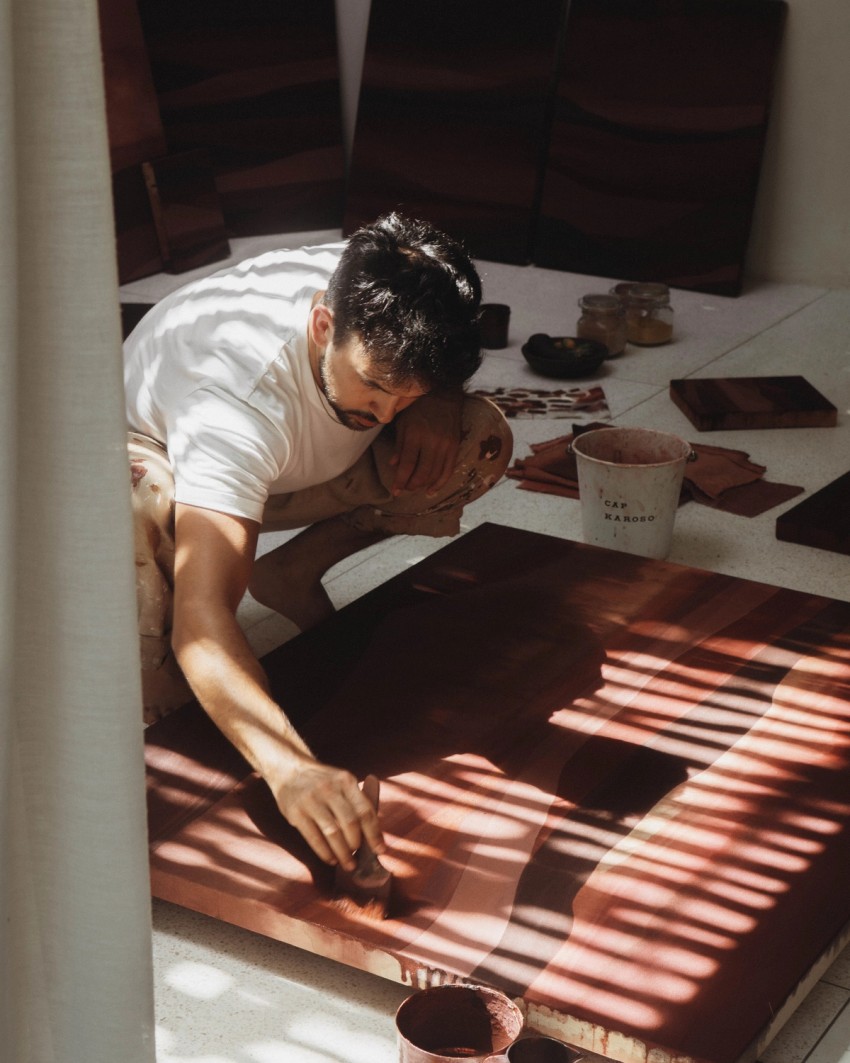
Sumba Artist Residency at Cap Karoso
Colors of Sumba: A Residency Rooted in Land, Culture, and Process
When I arrived in Sumba, I did not come with a fixed idea. I had canvas, tools, and a quiet intention to let the place guide the work. I had no set outcome, just space to explore. That kind of openness is not always easy to find, and Cap Karoso created the right environment for it.
What followed was something beyond art making. Sumba offered a shift in pace, a deeper respect for process, and maybe most importantly a stronger connection to people and tradition.
Working With What the Island Gives
I visited multiple Sumbanese dyeing villages, learning traditional techniques and stories passed down through generations. I discovered how mahogany bark can be used to produce red brown tones, taramanu wood for golden yellow, and yay mall wood for a vivid red. I also learned about the use of local herbs for medicine, revealing a deep interconnection between colour, healing, and land.
But perhaps the most transformative material I worked with was the red pigment derived from the betel chewing ritual, a blend of sirih leaf, pinang nut, and kapur lime paste. Widely used across Indonesia, this mixture is chewed for its mild psychoactive effects, producing a vivid red colour when it reacts with saliva. It stains lips, teeth, and fingers, and now, canvas.
This ritual is not only social or sensory. It is deeply symbolic. In Sumba, red is the colour of vitality, connection, and protection. To paint with it was to work with something alive, a substance that carries centuries of tradition and shared experience. It felt potent, almost forbidden. A drug turned dye. A ritual turned art.
This collection of paintings, a set of ten works created entirely on site, became what I call the Sumba Series. It explores groundedness, rest, and emotional depth. Each piece was built slowly through intuitive processes of soaking, staining, and pouring, allowing the materials to settle into layered, meditative forms. The series evokes a deep sense of calm, contentment, and belonging. Here, red speaks not of urgency but of warmth, safety, and the steady rhythm of simply being.
In many ways, this work is an invitation to slow down. To take a breath. To feel the groundedness of deep red hues. In a world that moves so quickly, these pieces ask you to pause. To sit with colour, silence, and the memory it holds.
Hierarchy, Respect, and the Meaning of Colour
Sumba is a place where tradition is not just remembered. It is practiced. The way people here hold onto their customs from generation to generation is something I deeply admire. Whether through storytelling, ceremony, or craft, there is a visible thread connecting elders to children. You see it in families. You feel it in villages.
There is pride in that kind of continuity, and there is also responsibility. No one is trying to modernise just for the sake of it. Things are held with care.
One thing I quickly learned is how important hierarchy is in Sumbanese culture. Everything has an order, from village structure to daily life to the way a piece of cloth is passed down. And that order is respected. It is not questioned but embraced as part of what holds the community together.
As an artist who often works with flow and freedom, stepping into a culture where structure is sacred was humbling. It reminded me that freedom and structure can work together. A clear sense of place and role does not limit creativity. It can actually deepen it.
In Sumba, colour is not just decoration. It is identity. Each shade has a purpose. It tells you who someone is, where they come from, what their role in society is. It is a form of unspoken language.
That completely changed how I thought about colour during the residency. In my practice, I usually let pigment guide the mood. But in Sumba, I started to ask: what does this colour mean here? What does it say about the land or the people who use it? That layer of meaning added something deeper to the process. A new level of respect.
Gratitude
This residency was not just about making a new series. It was about listening. To the land, to people, to silence, to rhythm. The paintings I created there carry all of that. They are layered with earth, smoke, stories, and shared time. They are not just about Sumba. But they could not have been made anywhere else.
To the team at Cap Karoso, thank you for holding space for artists to explore slowly and honestly. And to the artisans, elders, and families who welcomed me in, thank you for sharing your knowledge, your time, and your way of life.
There is something rare about a place that still moves at the pace of nature. I am glad I got to be part of it, even for a little while.
Looking Ahead
While still on the residency, I received news that I had been selected for the Swatch Art Peace Hotel Residency in Shanghai, a four month artist residency alongside 18 other international artists. I remember sharing the news with a woman staying at the hotel who was curious about my work. When I told her, she smiled and said I should be proud. She knew the residency and understood its significance. That moment stayed with me.
The Swatch Art Peace Hotel is one of the world’s most prestigious artist residencies, offering time, space, and community in the heart of one of Asia’s most creative and fast moving cities. To be invited into that context, after weeks of grounding and deep reflection in Sumba, feels like a powerful next step, and a reminder that slow, honest work resonates far beyond where it is made.
More soon.